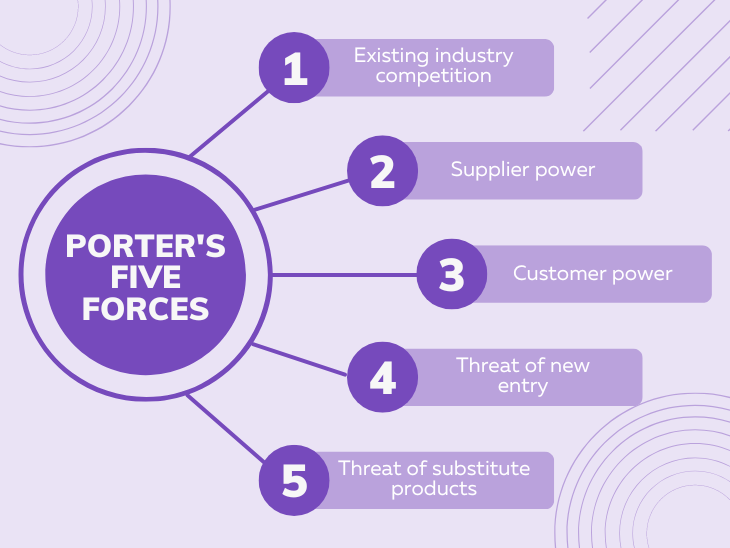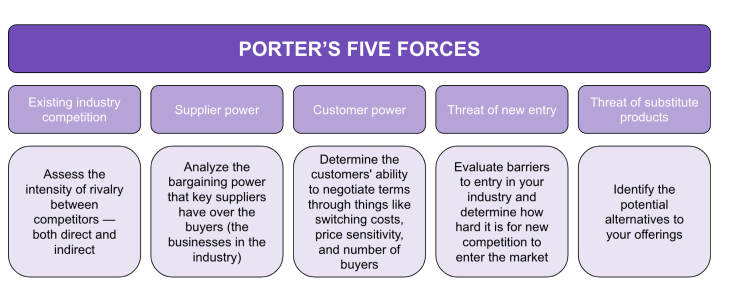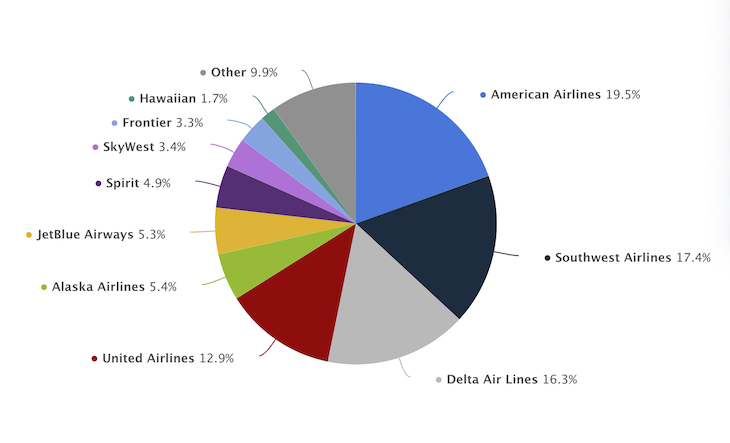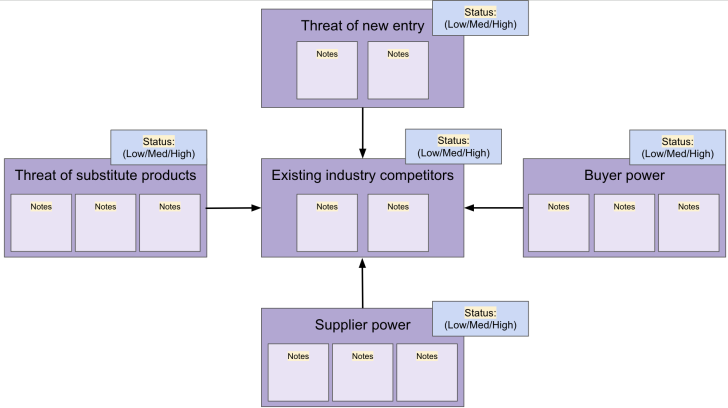Editor’s note: This article was updated 17 May, 2023 to add an explanation of how to conduct Porter’s Five Forces analysis and to re-structure existing information within the article.

As a product manager or a product owner, you often need to make a decision on whether to enter into a new market with your product. Before jumping in, it is important to scope out the market to better understand your chances of success.
Porter’s Five Forces Analysis is an excellent tool for exactly this purpose.
Porter’s Five Forces analysis is a model that identifies and examines five competitive forces that affect every industry. The structure of an industry is typically identified using the Five Forces analysis to develop company strategy. Any sector of the economy can benefit from using Porter’s model to better analyze industry rivalry and increase long-term profitability.
Michael E. Porter’s 1980 book Competitive Strategy: Techniques for Analyzing Industries and Competitors contains the Five Forces model.
Porter believed that the traditional approach to creating a strategy — a formula for competition, goals, and policies to attain those goals — was outdated and required updating. Porter examined the strategic needs of industrial sectors as a whole rather than simply individual enterprises. He did this by applying microeconomic principles to company strategy.
Porter’s Five Forces are:

Existing industry competition is the first of the Five Forces. This measures the number of competitors and their ability to undercut a firm. The power of a corporation decreases as the number of competitors and the number of comparable goods and services they provide increases.
All variables aside, if a competitor can provide a better deal or lower rates, suppliers and customers will most likely favor them. On the other hand, when there is little competition, a corporation has more bargaining power and can raise or lower prices as it pleases.
The Porter model’s second element examines the ability of suppliers to influence the terms and conditions of their business relationship with buyers. This includes things like how quickly suppliers can raise input costs or increase delivery times. It is influenced by the number of suppliers, the degree to which these inputs are special, and the cost to a corporation of switching providers.
The fewer suppliers in an industry, the higher the dependency a company has on them. As a result, the supplier is in a stronger position and has more flexibility with input costs and trade benefits. The opposite is also true. If there are more suppliers in an industry, the company tends to have more bargaining power with input costs.
Porter’s third force considers the market intensity. It is influenced by the number of consumers in the market and the products available in that market.
When a market is concentrated but products are undifferentiated, the buyer has greater bargaining power in price, quality, and services. You want to make sure your customers have low bargaining power to ensure your profit is at its highest.
Consider Apple: it has high switching costs for its consumers. They created the “Apple ecosystem” that allows for all their products to be interconnected and synchronized to provide the best user experience possible. Not only does switching brands cost the consumer money, but also time and convenience.
The threat of new entrants into a market has an impact on a company’s power as well. An established company’s position may be considerably undermined the quicker and cheaper it is for a rival to enter and overtake its market.
The stronger the entry barriers, the greater the chance for companies to charge higher rates and negotiate better conditions.
The fifth and final force focuses on alternatives. The presence of a substitute product threatens the sale of a company’s product. The more substitutes there are in a market, the less price flexibility a company has. A market with multiple alternatives forces a company to follow or mirror the price points of its competitors.
The above points explained what each force means, but now we’ll specifically go into how to conduct an analysis step-by-step. We’ll later go over a specific example in the proceeding section to help apply the information:

The first step is to figure out who your competitors are. Depending on your industry, you could have a lot of direct competitors (if you’re in a very saturated market, such as banking) or very few (if you’re in a specific and niche industry). Evaluating your competitors includes both direct and indirect competitors as well.
Direct competitors offer similar products or services and cater to the same target audience as your company. They compete for the same market share and often have comparable value propositions. Since direct competitors directly address the same customer needs, they pose a more immediate and significant threat to your business. Start high-level by looking at Google and analyzing industry reports to see the main players. You can also poll people and ask them to name companies they know of in the industry — this will help you identify which competitors are most popular and top-of-mind.
Indirect competitors, on the other hand, provide alternative solutions to the same customer needs, but through different products or services. Although they may not compete head-to-head with your company, they still pose a threat as they can satisfy your customers’ needs in alternative ways. For example, an indirect competitor to Netflix is a movie theater. Although they don’t compete directly in terms of product offerings, they still compete for the consumers’ time, attention, and discretionary spending on entertainment.
Assess the intensity of rivalry by considering factors such as the number of competitors, their relative size and market share, industry growth rate, and the level of differentiation among products or services.
Supplier power literally means the power of the suppliers. It isn’t a simple number or formula, unfortunately — usually, supplier power is said to be low, medium, or high.
To gauge supplier power, identify the key suppliers in your industry and analyze their bargaining power. If they raise prices, is it really easy to go find another supplier who will give you a cheaper rate? What if they decide that delivery times are increasing to seven days instead of four days — how easy is it to find an alternative? If the ability to switch suppliers is pretty easy, then supplier power in the industry is low. This means that the suppliers don’t have a lot of power or bargaining power.
To determine supplier power, consider factors like supplier concentration, the availability of alternative suppliers, and the importance of their goods or services to your business. Evaluate if suppliers can easily increase prices or reduce the quality of goods or services, which may affect the company’s profitability.
Customer power is similar to supplier power in that it’s asking how much power the customers have in this industry. In order to assess customer power, determine the concentration of buyers and their ability to dictate terms to your company. If your prices go too high, can they easily leave and use another company’s product or services? If so, customer power is high. Or is your company so one-of-a-kind that they have to stick with you to get what they need? If this is the case, customer power is low.
Monopolies have the lowest customer power of all. Customers are stuck no matter what, and will likely continue to pay high prices even if they don’t necessarily want to. Think of major electricity companies like Eversource (looking at you, New England folks) — if they’re the only electricity company in the area, customers will keep paying the high prices or else they get no electricity at all. Despite all the frustration around outages and high costs, there are little to no alternatives. Customer power is low.
Examine factors such as buyer volume, switching costs, price sensitivity, and product differentiation. Higher customer power may indicate that buyers can easily switch to competitors, demand lower prices, or negotiate more favorable terms.
How easy is it for new competition to enter the market? When analyzing the threat of new entry, evaluate barriers to entry in your industry. These can include expensive startup costs or capital requirements, regulatory restrictions, economies of scale, and brand loyalty. For example, think of an extreme like the aircraft industry. Companies like Boeing and Airbus dominate this sector because the costs of a new competitor entering this space are astronomically (ha, get it?) high.
A high level of barriers to entry reduces the likelihood of new competitors entering the market, thus enhancing the competitive position of existing companies. A low threat of new entry means it’s easy for new competitors to enter the market and swipe some of your customers away.
Lastly, we have the threat of substitutes. To determine the threat of substitute products, identify alternative products or services that could potentially replace your company’s offerings. This goes pretty hand-in-hand with the competitors part of the Five Forces model, as a lot of substitute products may overlap with your competitor’s offerings.
Consider factors such as the availability, price, and performance of these substitutes, as well as the ease of switching for customers. Also consider that substitute products don’t have to be actual products owned by competing companies. A substitute product for a note-taking app is a pen and paper. A high threat of substitutes can indicate increased competitive pressure and may require your company to innovate or differentiate its products to maintain its position.
To demonstrate how the model works in practice, let’s walk through an example Five Forces analysis for American Airlines.
We can analyze the U.S. airline industry’s existing competition through many variables. First, many low-cost carriers have entered the market. Low-cost airlines such as Spirit, Allegiant, and Frontier create high competition in the market catering to price-sensitive consumers.
There are also very strict industry regulations. Not only does this regulate safety, but it creates high fixed costs that make it extremely difficult for businesses to exit the market. This results in a stagnated industry; the businesses that are in the market stay in but rarely leave.
The switching costs for consumers are also low. Unless consumers have credit cards or fly miles with an airline, it is easy to switch to another for whatever reason. The fact that many industry participants are of a similar size (see graph below) intensifies the competition. When seen as a whole, the airline industry’s current rivals are very competitive.

The airline industry’s suppliers have very strong negotiating power. The two main inputs that airline firms require are fuel and aircrafts. However, the external environment — which the airline firms themselves have limited influence over — has a significant impact on these inputs.
Oil is a limited resource that is vulnerable to significant swings in price due to geopolitical factors. We saw this post-pandemic when the price of flights skyrocketed because fuel was so expensive.
The type of aircraft is also something airlines have little negotiating power over. For instance, there are only two major aircraft providers: Boeing and Airbus. This means that they have major control over pricing and other variables.
Customers have significant negotiating power in the airline industry. The prices of various airlines are available for comparison at the click of a button. Because of the low switching costs and the convenience of price comparisons, customers are more likely to fly with the cheapest airline.
In an attempt to reduce this, airlines offer credit cards, frequent flier miles, and rewards to increase switching costs and create stronger brand loyalty. Despite this, brand loyalty is not as strong as price sensitivity in the airline industry.
It is safe to say that the threat posed by new competitors in the aviation sector is low to medium. To launch an airline firm, you have to invest significantly upfront (e.g., purchasing aircrafts). Additionally, it can be difficult to acquire the licenses, insurance, distribution networks, and other qualifications that newcomers require (e.g., access to flight routes).
It is reasonable to assume that current players have amassed a sizable amount of experience over the years to reduce expenses and improve service standards. A newcomer will probably lack this kind of knowledge, which will put them at a competitive disadvantage from the outset.
The airline industry generally fulfills the need for travel. There are many alternatives that you can take for travel instead of flying. You can decide to travel via train, bus, or car, depending on the distance and urgency.
In Asia, bullet trains and Maglev trains are becoming increasingly popular. Elon Musk also proposed the Hyperloop, a form of travel in which passengers would travel in capsules in a vacuum tube at speeds up to 1200 km/h. Both of these could pose a severe threat to the airline sector in the future.
The threat of substitutes in the airline business might be rated as at least medium to high when all of this is considered.
Attached here is a free, downloadable Five Forces template. This allows you to succinctly describe and collect all the relevant information required to conduct the Five Forces analysis. Each light purple box can denote an entity and each section can have any number of these boxes depending on the market. The template can also be used to highlight which of the five forces should have the highest priority for the business:

The advantages of Porter’s Five Forces are that they can help you:
Porter’s Five Forces provides a way to quantify the threat of substitutes, the threat of new competitors, and the bargaining power of suppliers and buyers. These factors taken together will estimate the industry’s competition intensity. This will help the business comprehend the industry’s present competition and modify its corporate strategy accordingly.
A company can identify its threats and strengths by understanding the buyer/supplier force, the risk of new competitors, and the alternatives in the market. The administration will be able to take preventative measures for the impending threats and determine the exact sectors where the company’s strengths lie.
Porter’s Five Forces are linked to three different groups: suppliers, consumers, and rivals. Identifying which groups have more power helps the business choose the most effective handling method.
The industry’s power of suppliers and buyers will assist the business in deciding how, if, or when to vertically integrate. According to the information provided by the Five Forces, the firm may easily do one of two things: carry out forward integration to acquire their customer side of the value chain or carry out backward integration to buy their supplier side of the value chain.
To lessen the risk of competition, the company can consider the idea of undertaking horizontal integration to acquire a rival in the market. This will help the company get insights into the competitive rivalry.
On a high level, corporate risk is the liabilities and threats that a firm encounters. The power of suppliers, consumers, and competitors can all be better understood by considering Porter’s Five Forces.
The corporation will be able to further understand its risks and respond to them more accurately. Companies will be able to prevent losses by placing more emphasis on spotting risks and controlling them before it’s too late.
Companies will then act more confidently when making business decisions if they can control risk.
A corporate strategy will try to determine a company’s total worth, define strategic objectives, and inspire staff to meet those objectives. It is an ongoing process that needs to be carefully customized to react adequately to shifting market conditions.
Taking the impact of external forces into account, Porter’s Five Forces offers useful information to create or improve corporate strategy which maximizes value.
Porter’s Five Forces and SWOT are essentially two different approaches to address the same fundamental questions:
These are helpful on a personal level, but they’re also significant inquiries for possible investors. It is necessary that they grasp this type of analysis. Choosing an investment strategy is partially a question of personal preference, but it also depends on how developed a firm is and how developed its respective sector is.
The Five Forces approach is typically more helpful and instructive for young businesses and emerging industries, whereas SWOT provides more insight into the present and future of more mature businesses.
When examining a corporation’s competitive environment, the most crucial factors to be taken into account are included in Porter’s Five Forces model.
High threat levels often indicate a potential revenue loss in the future, and vice versa. For example, if entry barriers are absent, a young business in a rapidly expanding field may find itself shut out very quickly. Similarly, a corporation providing products with many alternatives might not be able to use pricing power to increase margins and may even lose market share to rivals.
Businesses use Porter’s approach because it compels them to consider their whole sector when developing long-term strategies instead of short-term business plans. Porter’s Five Forces model still is a vital tool utilized to develop a corporate plan.
Featured image source: IconScout

LogRocket identifies friction points in the user experience so you can make informed decisions about product and design changes that must happen to hit your goals.
With LogRocket, you can understand the scope of the issues affecting your product and prioritize the changes that need to be made. LogRocket simplifies workflows by allowing Engineering, Product, UX, and Design teams to work from the same data as you, eliminating any confusion about what needs to be done.
Get your teams on the same page — try LogRocket today.

A practical framework for PMs to use AI in ideation without sacrificing judgment, strategy, or decision quality.

A practical five minute revenue estimation method to help product managers compare ideas, drop low impact features, and prioritize smarter.

A practical guide for PMs who want to stop being bottlenecks, delegate smarter, and lead teams effectively with a clear ownership framework.

Stop letting unreliable data block features. Treat data as inventory to track quality, ownership, and ship with confidence.